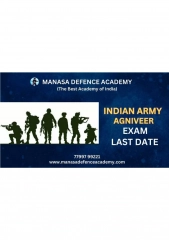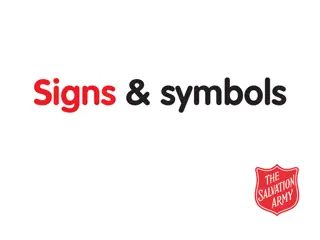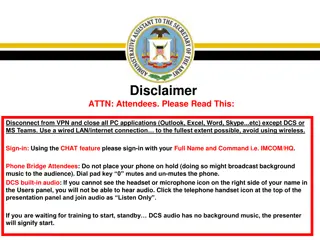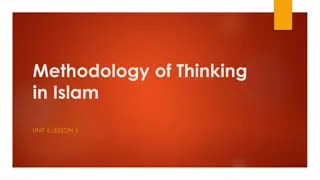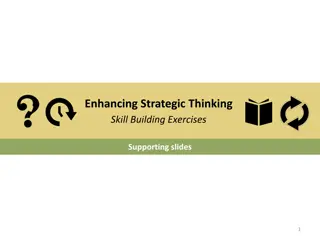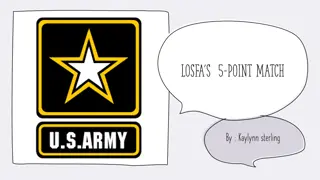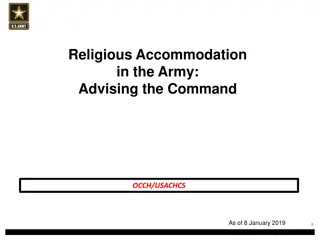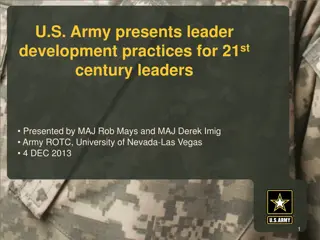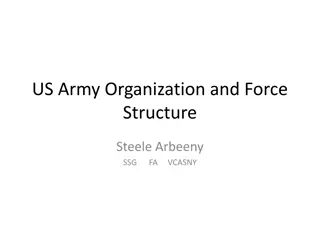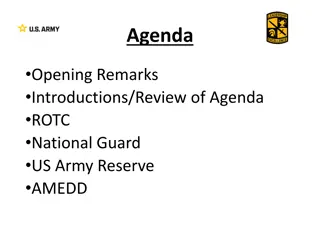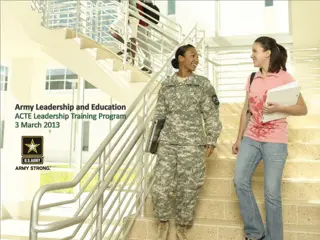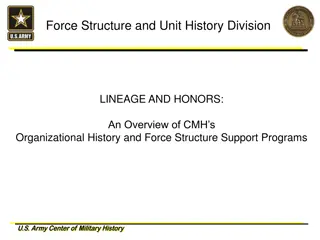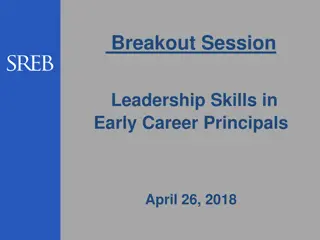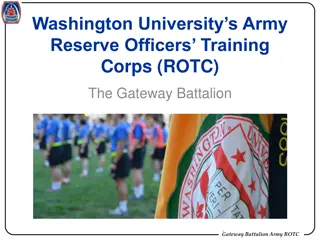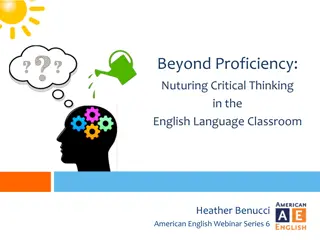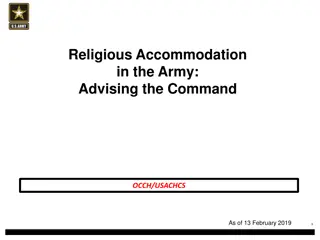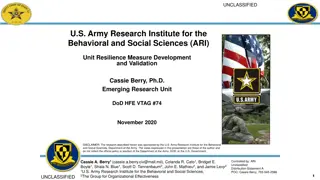Developing Strategic Thinking Skills for Future Army Leaders
Enhancing strategic thinking skills is essential for future army leaders to anticipate change, think long-term, and serve national interests effectively. The provided slides outline foundational skills needed for strategic thinking, emphasizing competencies like information gathering, critical thinking, and understanding historical contexts.
Download Presentation

Please find below an Image/Link to download the presentation.
The content on the website is provided AS IS for your information and personal use only. It may not be sold, licensed, or shared on other websites without obtaining consent from the author. Download presentation by click this link. If you encounter any issues during the download, it is possible that the publisher has removed the file from their server.
E N D
Presentation Transcript
Enhancing Strategic Thinking Skill Building Exercises Supporting slides 1
NOTE TO FACILITATORS The slides in this deck have been developed to provide the following to participants: 1)Context for the skill-building exercise including the importance of practicing foundational skills to become an effective strategic thinker 2)An overview of the exercise including the purpose, activities, and learning objectives 3)Brief tutorial facilitators may choose to adapt, add to, or re-arrange any portions of this slide deck to introduce the exercise to participants. Slides contained in the Background and Context portion of the slide deck (slides 3 10) appear in the slide decks for each of the four exercises. 2
CURRENT AND FUTURE ARMY LEADERS NEED TO BE ABLE TO THINK STRATEGICALLY Army leaders need to anticipate change, think long term, envision potential futures, and exploit opportunities to serve national interests Before Army leaders step into positions that require them to function as strategic thinkers and planners, they need to hone the building block skills that underpin strategic thinking Image credit: http://www.hawaiiarmyweekly.com/storage/2016/02/2378779-768x510.jpg 4
WHAT SKILLS ARE FOUNDATIONAL TO STRATEGIC THINKING ABILITY? Competency A Strategic Thinker continuously scans the environment seeks information from disparate sources suspends judgment and maintains an open mind considers other perspectives possesses advanced listening and research skills Comprehensive Information Gathering is a lifelong learner iteratively tests, reflects on, conceptualizes, and manages knowledge to gain insights on the environment continuously examines his/her own thinking Learning identifies the essential aspects of a situation questions assumptions and asks relevant questions seeks to identify meaningful connections and distinctions understands nuance considers the limits of data Critical Thinking 5
WHAT SKILLS ARE FOUNDATIONAL TO STRATEGIC THINKING ABILITY? (CONT D.) Competency A Strategic Thinker understands historical and contemporary contexts. recognizes patterns. forecasts possible futures. anticipates second-and third-order effects. has a long-term perspective. Thinking in Time generates creative and novel ideas, concepts, and approaches, independent of conventional norms. Innovative Thinking uses a holistic perspective of the dynamic and complex environment. identifies interrelationships and integrates disparate factors into a comprehensive whole. Systems Thinking 6
WHAT ELSE IS IMPORTANT TO STRATEGIC THINKING ABILITY? Competency A Strategic Thinker Has a solid foundation for strategic thinking based in: a broad general knowledge of many disciplines (e.g., geo-politics, world religions/cultures, economics, technology, sociology). knowledge specific to a strategic environment (e.g., local/regional customs, history, stakeholders). Knowledge Leverages the capabilities of others in a team or informal network (e.g., through cooperation, leadership, building trust, conflict management) to supplement his/her own strategic thinking. Collaboration Communicates candidly and effectively to gain individual understanding and move to the shared understanding required for strategy implementation. Is adept in the use of multiple media formats (oral, written, visual). Communicates well with diverse audiences that require tailored and persuasive messages. Communication Is intellectually humble. Accounts for his/her own natural limitations and biases related to emotion, perspective, and self-interest. Maintains respect for differing values and priorities. Emotional Regulation 7
STRATEGIC THINKING SKILL-BUILDING EXERCISES WILL HELP YOU BUILD SKILLS NEEDED FOR STRATEGIC THINKING. Exercises in this series include: Reflecting on Experience--provides practice in reflective thinking, learning from experience. Asking Powerful Questions--provides practice in questioning. Telling a Story--provides practice in systems thinking, synthesis. Envisioning Potential Futures -provides practice in thinking in time, strategic foresight. 8
THINK OF THESE EXERCISES AS COMPARABLE TO AN ATHLETIC DRILL. Professional basketball players don t just play a lot of basketball. They practice component skills ball handling, shooting baskets, rebounding, and footwork. Practicing these foundational skills repeatedly and over time is essential to becoming a skilled basketball player. Image credit: shutterstock.com 9
DEVELOPING STRATEGIC THINKING ABILITY ALSO REQUIRES TIME, PRACTICE, AND ATTENTION TO FOUNDATIONAL SKILLS. Doing any of the exercises once or twice will not transform you into a strategic thinker. They are analogous to the drills that athletes use to hone their skills. Developing advanced ST skills means repeatedly practicing the foundational skills necessary to become a great strategic thinker. The exercises can help you practice some of the (many) skills you ll need in order to become a skilled strategic thinker. Image credit: shutterstock.com 10
Overview Asking Powerful Questions 11
WHATS THE PURPOSE OF THIS EXERCISE? Primary Purpose: To build your questioning skills. Questioning A learning strategy that can be used to understand problems, relevant factors, interdependencies, assumptions, and differing perspectives more deeply. Secondary Purpose: To practice generating ideas for how to answer questions. Image credit: shutterstock.com 12
THE EXERCISE WILL ALSO HELP YOU PRACTICE THESE ADDITIONAL SKILLS: Systems thinking Recognizing and describing relationships and interdependencies among factors that might otherwise appear unrelated. Synthesis Integrating seemingly disparate pieces of information into a coherent whole. Self-awareness Mindfulness of the perspectives, assumptions, and biases you bring to a situation. 13
WHAT WILL I DO IN THE EXERCISE? View a photo image Generate a set of questions that can help you understand the problem in the image Work as a group to organize, categorize, and label the questions Develop a plan for answering the questions Reflecton exercise; discuss as a group 14
WHAT MATERIALS DO I NEED? Participant Guide (provided by facilitator) Pen/pencil Notebook/pad of paper Image credit: shutterstock.com 15
WHAT WILL I GAIN FROM THIS EXERCISE? Generate a wider variety of questions to deepen learning and enhance understanding Recognize characteristics of different types of questions. Recognize characteristics of powerful questions Appreciate the kinds of information that can be gained from different types of questions. Develop ideas for seeking answers to a wide-ranging set of questions. 16
Brief Tutorial Phase I 17
WHY DOES QUESTIONING MATTER? Questioning skills are a key building block to developing our strategic thinking abilities Strategic thinkers are active learners. Questioning can take us beyond information- gathering by o promoting critical thinking and deep learning o helping us identify and challenge assumptions o helping us create, reinforce, alter, or destroy assumptions o allowing us to explore alterative perspectives Image credit: shutterstock.com 18
WHATS HARD ABOUT ASKING INSIGHTFUL QUESTIONS? We tend to have a set of questions we typically ask (depending on our role, education, experience) and rarely move beyond those questions. We often want to identify solutions quickly in order to move to action; we do not take the time to explore the problem. So we omay end up with solutions that do not address the underlying problem. odo not develop advanced skills at asking questions that lead to deeper understanding. 19
WHATS HARD ABOUT ASKING INSIGHTFUL QUESTIONS? (Cont d.) We often start with a pre-determined view of the problem; we only look at it one way. Questions we pose may be too narrowly focused on a small portion of the problem and, therefore, provide limited information. Image credit: shutterstock.com 20
HIERARCHY OF POWERFUL QUESTIONS Questions have varying amounts of power High Power Why Any question can become more powerful by moving up the pyramid How What Powerful open-ended questions are best for o inquiring Where Which When Who o deeper understanding Closed-ended (yes/no) Low Power o reflective thinking 21
HIERARCHY OF POWERFUL QUESTIONS: EXAMPLES High Power Why Why are we considering this policy? How What How could we implement this policy? Where Which When Who Should we implement this policy? Low Power Closed-ended (yes/no) 22
THREE DIMENSIONS OF POWERFUL QUESTIONS Powerful questions are defined by three dimensions: Scope o Greater scope: encompass more people, more volume, more time, or more concerns Architecture Meaning/Context o Challenge assumptions o Generate energy and encourage exploration o Touch a deeper meaning Architecture o Hierarchy of powerful questions o Open-ended vs. closed-ended questions Meaning/Context Scope Vogt, E. E. (1994). The art and architecture of powerful questions. MicroMentor Corporate Learning Journal. Available through http://www.cashflow88.com/decisiones/ powerfulquestions.pdf. 23
THREE DIMENSIONS OF POWERFUL QUESTIONS EXAMPLES Scope o How does our decision affect the security of our unit? o How does our decision affect the security of this nation? Architecture Meaning/Context o How can we compete with them? o How can we collaborate with them? Architecture. Compare: o Should we implement the policy? o How could we implement the policy? o Why are we considering this policy? Meaning/Context Scope Vogt, E. E. (1994). The art and architecture of powerful questions. MicroMentor Corporate Learning Journal. Available through http://www.cashflow88.com/decisiones/ powerfulquestions.pdf. 24
SKILLED QUESTIONING STARTS WITH THE ABILITY TO ASK A VARIETY OF TYPES OF QUESTIONS. Insightful questions are open-ended (ask for more than a yes or a no ). typically start with who, what, where, when, why, or how. inform rather than seek agreement with a point of view. encourage people to think more broadly and deeply. enable people to understand the situation in a holistic way. help identify areas of ambiguity and paradox. allow people to understand assumptions they (and others) hold. invite deep reflection. encourage more questions. stimulate reflective thinking. 25
INSIGHTFUL QUESTIONS CAN LEAD TO A FULLER UNDERSTANDING OF A PROBLEM. Questioning can take place at any time and in any situation. It can be used to understand a bigger picture: data, events, attitudes, emotions, assumptions, and behaviors. reveal the real problem often different than what we first thought. Image credit: shutterstock.com 26
TIPS FOR ASKING INSIGHTFUL QUESTIONS Use open-ended rather than closed-ended questions Ask a variety of types of questions: o Not solely what happened? or what is going on? o Also ask, how? why? what if? and what does this mean for x? Seek information that reflects contradictory, unfamiliar, or unpopular points of view. 27
Brief Tutorial Phase II 28
FINDING ANSWERS TO COMPLEX QUESTIONS CAN BE DIFFICULT, BECAUSE Operational settings are awash in data. o Challenge: Figuring out what data to focus on and what to filter out. The search for information can be unending. o Challenge: Deciding how and when the information gathered is enough for now. The focus of information searches is often too narrow. o Challenge: Allowing for breadth and depth of understanding. 29
FINDING ANSWERS TO COMPLEX QUESTIONS CAN BE DIFFICULT, BECAUSE It can be unclear where to look for information. We may rely too much on familiar sources and limit learning and understanding. Seeking information that reflects contradictory, unpopular, or unfamiliar points of view can be uncomfortable, but is essential. Our view of the situation may change as information is revealed. This may lead to a new set of questions or reframing of the problem. 30




